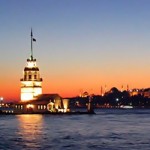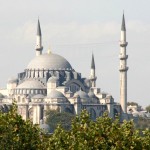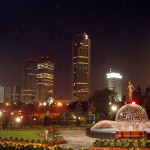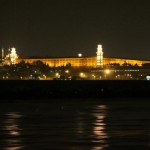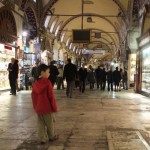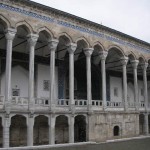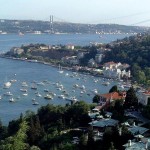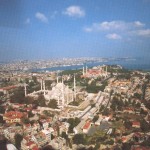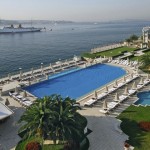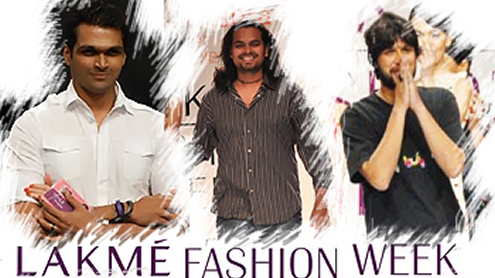 Dr.Shahid Qayyum talks about his visit to Istanbul:
Dr.Shahid Qayyum talks about his visit to Istanbul:
Istanbul, the only metropolis in the world located on two continents, was founded by a Roman king Constantine the Great, on the Greek city of Byzantine which initially became known as Constantinople, the name later changed by the Ottoman rulers. The capital of Istanbul province it is Turkey’s most populous city and its cultural and financial centre. Historically it has been part of the Roman and Byzantine Empires, being the capital of the later, followed by Latin and ultimately the Ottoman Empires before Turkey was declared a republic in 1923 by Mustafa Kemal Attaturk and the capital moved to Ankara. Napoleon Bona Parte complimented the city by saying,”If the Earth was a single state, Istanbul would be its capital” and of late it has had the honour of being chosen the European Capital of Culture for the year 2010.
Istanbul, with its wide boulevards, modern avenues and imposing public squares is located on the Bosporus strait, which separates its European part from the Asian, and, like Rome, sprawls over seven hills. Life in the city is colourful and vibrant and continues to bustle side by side with many carefully protected Roman, Byzantine and Ottoman monuments which naturally smell history. More than half of its population lives on the European side of the city. It has temperate continental climate with hot and humid summers and cold and rainy, often snowy, winters. According to the tourist information brochures the summer day time temperatures average around 28 degree Celsius but when we landed there during the last week of April, it was just about comfortable at night and unbearable in the day. On the May Day we took a trip to the Bosporus bridge and it was sizzling hot with pungent, dust raising winds blowing across and giving the metropolis a deserted and desolate look, with only the armoured vehicles forming the bulk of the traffic on the city roads. To our disbelief the weather took a complete U-turn during the next three days. It was biting cold outside with chill in the air and we had to take out our woolies to move out doors.
We landed at the Istanbul International airport at night and hired a taxi to take us to a hotel just opposite the central railway station. A Turkish colleague had made the hotel reservations for us but on reaching the place we found that there was some misunderstanding and we were booked for the coming week. There was no room available and we had to look for an other hotel at the middle of the night. It was high season and ‘no vacancy’ sign jeered us at most places. The English-illiterate cab driver knew only one word of English and that was ‘pound’ (sterling), the currency we had agreed to pay him in, and we were desperately looking for the accommodation with the taxi meter running faster than the taxi itself and my eyes constantly watching it, as well as, looking for an available hotel room.
We did find a hotel but quite late in the night and moved in as well but the first thing we did in the morning was to find a better hotel nearby. As we went to check out of the first hotel the clerk at the desk wanted an explanation for the change, which we could not give because of the language bar. The gentleman became very emotional and, holding my hands warmly, kept repeating the words ‘Pakistan Turkey brother brother’. We appreciated his feelings and love for our country but had to move out, managing to give some explanation through the courtesy of another guest who bridged this communication gap with some difficulty. Unlike the Arabs, most Turks Harbour very warm feelings for the Pakistanis. Missing a reservation in the hotel we were initially booked in, turned out to be a blessing in disguise as the new hotel was located in a posh area and within very close range of the heritage sites, with Bosporus strait and the Blue mosque clearly visible from our hotel window.
Bosporus sea was the focal point of a large number of ancient sites, among them Topkapi Sarayi, the Blue mosque and Aya Sofia to name a few. This strait is thirty-two km long connecting the Black Sea to the sea of Marmara with onward links to the Mediterranean. Its width varies from 500 meters to 3 km and passes through the heart of Istanbul with three modern bridges joining the two continents. Bosporus, regarded as a summer resort during the Ottoman period, has a skyline studded with domes and minarets and Istanbul Modern Art Museum, several Ottoman palaces and at least two fortresses, besides wooden sea side chalets and sea front mansions lining its banks. The legend is that Noah’s flood started here. Bosporus Strait’s entry to the Black sea was blocked by huge rocks millions of years ago and, as this area lies on the fault line of African and Eurasian tectonic plates, a deadly earthquake relieved this blockage raising the level of the Dead Sea and causing the floods. Mount Ararat, the final landing site of the Noah’s arch (ref; Bible) is situated close by. The researchers claim the authenticity of their findings.
Topkapi Palace, overlooking Bosporus, was the home of the Ottoman sultans for 400 years who lived there in over 100 rooms with their concubines, their children and black and white servants. The palace was constructed on an ancient olive grove site and is different from the European concept as it is built around four court yards. A Baghdad pavilion, a throne room and tower of justice are some landmark structures in the palace. It has now been converted into a museum and the personal belongings of Prophet Mohammed (PBUH) and the earliest Caliphs of Islam are preserved here. Aya Sofia, also known as the church of Divine wisdom, is just next door and artifacts of Muslim influence and rare calligraphies are displayed here. Initially a church and once second only to St.Peters in size, Aya Sofia was converted to a mosque by the Ottoman rulers. Now a museum since 1935 it houses the tombs of the Sultans and other royalties in its outer court yard. It has paintings of Christian saints as well.
Mosques, they say, are the most sublime architectural expressions of Islamic piety and there are a good number of them in Istanbul. Blue Mosque, the largest in the city, is the landmark symbol of Istanbul and the only mosque with six minarets. It is also called Sultan mosque and is studded with blue hand painted n.i.k tiles. Traditionally the ottoman buildings were made of ornate wood and only the state buildings such as palaces were made of stone. The wooden chalets were later replaced by brick structures.
The Grand Bazaar, one of the largest covered markets in the world, is an amazing labyrinth with around 4000 shops under one roof and is a must-see place in Istanbul. This 500 year old market with sixty-four streets and twenty-two gates is an overwhelming place, selling pretty much every thing one can imagine. It is almost a small town in itself with mosques, workshops, restaurants, money changers and a police station within its parameters. Sitting at a pavement cafe for refreshments and watching the hustle and bustle of Grand Bazaar my thought process deviated to the historical Souk Hameedia in Damascus. Drawing parallels between the two is unfair but both Istanbul and Damascus being contemporaries in history, the Syrian covered market was pathetic while the Grand Bazaar has a lot to boast about.
While the Pakistani dress, our identity in a foreign country, was of considerable help on our trip to Rome, the Italian capital, it was a source of utmost embarrassment in Turkey. I was on a day long guided tour of the historic city of Istanbul with my family enjoying the place and the unmatched Turkish hospitality when, during the refreshment break, our tour guide, a Turkish lady of Hungarian descent married to an ethnic Turk, came down to our table and sought our permission to join us. Being the only Pakistani couple in the full bus load of tourists, she singled us out and bombarded us with various questions regarding Z.A.Bhutto’s anticipated execution (our Apex court had passed a death sentence for the deposed leader). It was really embarrassing to face such an intriguing situation in a foreign land. She resumed conducting the tour after the break but we did feel sheepish through the rest of the day. I am sure many expatriate Pakistanis must have found themselves in identical situations then and even later when our elected governments get toppled every so often by uniformed carpet baggers. Some time it pays to conceal the identity.
The wonderful trip to Istanbul came to a close and we left the brotherly country with the same feelings as Pope Benedict XVI, who while completing his official trip to Istanbul after assuming charge of the Vatican, said “I am leaving half of my heart in Istanbul”.


